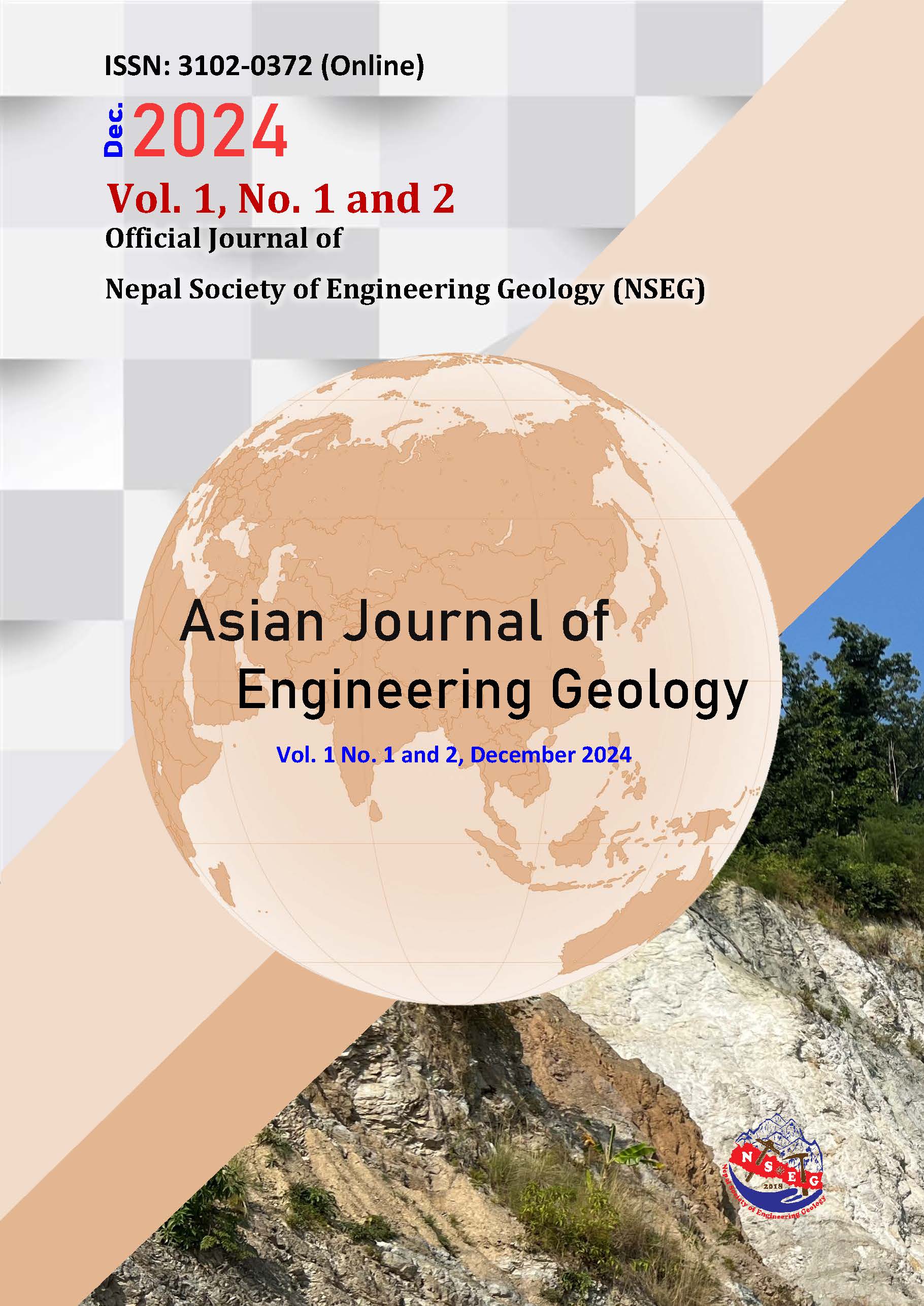Numerical Modeling of Debris Flow Originating from Topographic Hollows at Koyalghari and Simaltal Area along Narayangadh-Mugling Highway
DOI:
https://doi.org/10.64862/ajeg.2025.201.02Keywords:
Cohens Kappa, Debris flow, LISEM model, Physical based modelling, Runout distance, MuglingAbstract
Assessment of debris flow runout extent is essential for evaluating landslide hazards and formulating effective land-use plans. This study employed the openly available LISEM (LImburg Soil Erosion Model) to simulate debris flow runout using diverse geospatial and geotechnical input data. By incorporating the spatial distribution of soil geotechnical parameters, the model effectively estimated debris flow runout based on debris height. The research integrates rainfall-induced slope failure and runout dynamics through a physically based modeling approach to predict potential landslide impact zones under extreme rainfall conditions corresponding to 5-, 10-, and 25-year return periods. The study area is the Koyalghari region along the Narayangadh-Mugling Highway in central Nepal. Model validation was conducted in the Simaltal area using the Cohen’s Kappa statistic, yielding a value of approximately 0.7, which indicates substantial agreement with observed debris flow patterns. For the analyzed rainfall scenarios, the estimated average debris flow height ranged from 0.92 m to 1.1 m on the highway, highlighting the potential for severe damage to road infrastructure and traffic during extreme events. Overall, the study demonstrates that a physically based model incorporating geotechnical soil parameters can reliably estimate debris flow runout and deposit height, offering valuable insights for hazard assessment, risk mitigation, and land-use planning in landslide-prone regions such as the Narayangadh-Mugling Highway.
References
Berti, M., and Simoni, A. (2007). Prediction of debris flow inundation areas using empirical mobility relationships. Geomorphology, 90(1–2), 144–161. https://doi.org/10.1016/j.geomorph.2007.01.014
Bout, B., Lombardo, L., van Westen, C. J., and Jetten, V. G. (2018). Integration of two-phase solid fluid equations in a catchment model for flash floods, debris flows and shallow slope failures. Environmental Modelling and Software, 105, 1–16. https://doi.org/10.1016/j.envsoft.2018.03.019
Chen, H., and Lee, C. (2000). Numerical simulation of debris flows. Canadian Geotechnical Journal, 37(1), 146–160. https://doi.org/10.1139/t99-091
Chicco, D., Warrens, M. J., and Jurman, G. (2021). The Matthews correlation coefficient (MCC) is more informative than Cohen’s kappa and Brier score in binary classification assessment. IEEE Access, 9, 78368–78381. https://doi.org/10.1109/ACCESS.2021.3084050
Chow, V. T. (1959). Open-channel hydraulics. McGraw-Hill.
Cohen, J. (1960). A coefficient of agreement for nominal scales. Educational and Psychological Measurement, 20(1), 37–46. https://doi.org/10.1177/001316446002000104
Dahal, R. K., and Hasegawa, S. (2008). Representative rainfall thresholds for landslides in the Nepal Himalaya. Geomorphology, 100(3–4), 429–443. https://doi.org/10.1016/j.geomorph.2008.01.014
Das, B. M. (2008). Advanced soil mechanics. Taylor and Francis.
Hungr, O., McDougall, S., and Bovis, M. (2005). Entrainment of material by debris flows. In M. Jakob and O. Hungr (Eds.), Debris-flow hazards and related phenomena (pp. 135–158). Springer.
Hussin, H. Y. (2011). Probabilistic run-out modeling of a debris flow in Barcelonnette, France (Master’s thesis). University of Twente, Faculty of Geo-Information and Earth Observation (ITC).
Jakob, M., and Hungr, O. (Eds.). (2005). Debris-flow hazards and related phenomena. Springer. https://doi.org/10.1007/b138657
Landis, J. R., and Koch, G. G. (1977). The measurement of observer agreement for categorical data. Biometrics, 33(1), 159–174. https://doi.org/10.2307/2529310
Paudel, B., Fall, M., and Daneshfar, B. (2021). GIS-based assessment of debris flow runout in Kulekhani Watershed, Nepal. Geotechnical and Geological Engineering, 39, 2755–2775. https://doi.org/10.1007/s10706-021-01678-9
Pudasaini, S. P. (2012). A general two-phase debris flow model. Journal of Geophysical Research: Earth Surface, 117(F3), 1–28. https://doi.org/10.1029/2011JF002186
Quan Luna, B., Blahut, J., Camera, C., van Westen, C., Apuani, T., Jetten, V., and Sterlacchini, S. (2014). Physically based dynamic run-out modelling for quantitative debris flow risk assessment: A case study in Tresenda, northern Italy. Environmental Earth Sciences, 72, 645–661. https://doi.org/10.1007/s12665-013-2989-0
Rossi, M., Guzzetti, F., Reichenbach, P., Mondini, A. C., and Peruccacci, S. (2010). Optimal landslide susceptibility modeling based on multiple forecasts. Geomorphology, 278, 160–175. https://doi.org/10.1016/j.geomorph.2016.11.021
Stöcklin, J., and Bhattarai, K. (1977). Geology of Kathmandu area and Central Mahabharat range: Nepal Himalaya [Unpublished report]. Department of Mines and Geology/UNDP.
Upreti, B. N., and Dhital, M. (1996). Landslide studies and management in Nepal. International Centre for Integrated Mountain Development (ICIMOD).
Downloads
Published
Data Availability Statement
No datasets were generated or analyzed during the current study.
Issue
Section
License
Copyright (c) 2025 Nepal Society of Engineering Geology (NSEG)

This work is licensed under a Creative Commons Attribution 4.0 International License.




